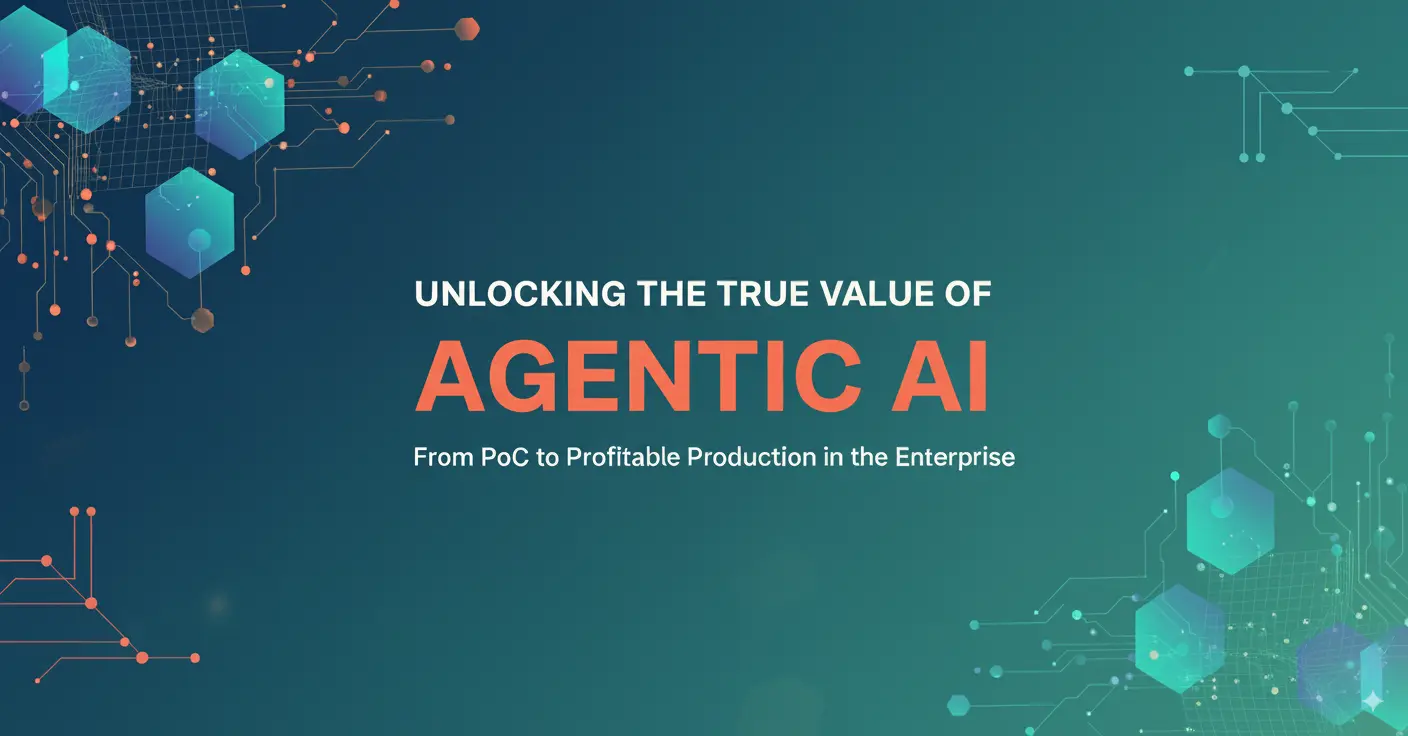
Unlocking the True Value of Agentic AI in the Enterprise
As enterprises increasingly explore the adoption of Agentic AI, many are encountering challenges in moving from proof-of-concept (POC) to production. Despite the hype and promise, the actual value delivered often falls short. This blog explores how organizations can effectively adopt Agentic AI to maximize its value, minimize risks, and ensure sustainable innovation.
Understanding the Current Landscape
Why Agentic AI Initiatives Are Failing
Reports from institutions like MIT, Gartner, and others highlight a growing trend: many Agentic AI initiatives are failing to transition from POC to production. Enterprises are not unlocking the full potential value of these systems, often due to poor implementation strategies and lack of alignment with business goals.
The core issue isn't the technology itself, it's how organizations approach the adoption process. Many enterprises jump into AI initiatives based on market hype rather than carefully planned strategies that align with their specific needs and capabilities.
The Impact of Agentic AI on Enterprise Workflows
Redefining Processes and Interactions
Agentic AI is fundamentally reshaping how products and services are delivered. It affects:
- Internal workflows - Automating complex decision-making processes
- Business processes - Streamlining operations across departments
- Employee interactions with systems - Changing how people work with technology
This shift changes how tasks are executed, requiring a rethinking of how software behaves. Unlike traditional software that reacts to user inputs, Agentic AI can proactively take actions on behalf of users. This autonomy introduces both opportunities and risks that must be carefully managed.
The transformation isn't just about efficiency, it's about enabling entirely new ways of working that weren't previously possible.
Embracing New Business Models and Processes
Balancing Autonomy with Safety
Agentic AI opens doors to new workflows and business models that were previously unimaginable. However, its introduction must be:
- Safe - Protected by robust guardrails and error handling
- Observable - With clear visibility into decisions and actions
- Aligned with enterprise expectations - Meeting business objectives and compliance requirements
To achieve this balance, enterprises must evolve their service models and cross-functional capabilities to support Agentic AI responsibly. This means rethinking governance structures, risk management frameworks, and operational procedures.
Introducing AI with Control, Not Hype
The Importance of Transparency and Trust
AI should not be introduced based on market hype. Instead, it must be:
- Transparent - With clear explanations of how decisions are made
- Controlled - Operating within defined boundaries and permissions
- Trustworthy - Reliable and consistent in its behavior
Autonomy is powerful, but without proper oversight, it can lead to broken trust and increased risk. Enterprises must identify low-risk, high-value areas for AI adoption and gradually scale through disciplined innovation.
The key is starting small with well-defined use cases and building confidence before expanding to more complex scenarios.
Designing a Responsible Agentic AI Strategy
Key Principles for Enterprise Adoption
When designing an Agentic AI strategy, focus on these non-negotiable principles:
- Transparency - Every decision should be explainable
- Trust - Built through consistent, reliable performance
- Explainability - Clear reasoning behind AI actions
- Observability - Real-time monitoring and logging
- Auditability - Complete records for compliance and analysis
Every decision made by an AI agent should be logged, with metrics like reliability and failure rates clearly visible. Without feedback mechanisms, deploying AI in production increases risk and erodes trust.
These principles aren't just technical requirements, they're business imperatives that determine long-term success.
Aligning AI Strategy with Business Goals
From Use Case Discovery to Iterative Deployment
In complex enterprise environments with cross-functional workflows, success depends on aligning AI strategy with business objectives. The process includes:
- Identify high-impact, low-risk use cases - Start where AI can add immediate value with minimal risk
- Prioritize and refine them - Focus resources on the most promising opportunities
- Define success criteria - Establish clear metrics for measuring impact
- Introduce Agentic AI iteratively - Build confidence through gradual expansion
This approach ensures measurable outcomes and sustainable scaling. It also allows for learning and adjustment as the organization gains experience with AI systems.
Success requires close collaboration between business stakeholders and technical teams to ensure AI initiatives address real problems, not just impressive demos.
Avoiding the Pitfalls of Hype-Driven Deployment
Focus on Real Problems, Not Demos
Many enterprises fall into the trap of scaling AI based on flashy demos rather than real problems. This leads to failure because demos often don't translate to production environments with their complexity and constraints.
Instead of following the hype, successful organizations:
- Start with actual business problems - Address pain points that impact operations or customer experience
- Align with strategic roadmaps - Ensure AI initiatives support long-term business goals
- Conduct thorough POCs - Test solutions in realistic conditions before scaling
- Build confidence through iterative implementation - Prove value at each stage
This disciplined approach helps organizations gradually unlock AI value while minimizing risk and ensuring sustainable adoption.
Assessing Readiness Before Integration
Evaluate Technology, Culture, and Processes
Before integrating Agentic AI, organizations must assess multiple dimensions of readiness:
Technology Stack
- Current infrastructure capabilities
- Data quality and accessibility
- Integration requirements
- Security and compliance frameworks
Organizational Culture
- Openness to change and innovation
- Risk tolerance and governance preferences
- Collaboration across departments
- Leadership support for transformation
Stakeholder Readiness
- Technical skills and training needs
- Change management requirements
- Communication and expectation setting
Operating Model
- Process maturity and documentation
- Decision-making structures
- Performance measurement systems
Without proper assessment, integration challenges will arise, especially if foundational systems aren't evolved to support AI capabilities.
People and Culture: The Cornerstones of AI Adoption
Upskilling and Change Management
AI adoption is not just a technical shift, it's a cultural transformation. Successful enterprises must:
Invest in People
- Upskill employees - Provide training on working with AI systems
- Redesign roles - Adapt job descriptions to incorporate AI collaboration
- Foster adaptability - Build organizational resilience for ongoing change
Address Talent Gaps
- Identify skill requirements - Understand what capabilities are needed
- Drive continuous training - Implement ongoing learning programs
- Evaluate progress - Monitor adoption and adjust support as needed
The human element is often the determining factor in AI success. Technology may enable the transformation, but people make it work effectively and generate real business value.
Organizations that invest in their people alongside their technology consistently achieve better outcomes than those focused solely on technical implementation.
A Disciplined Path to AI Success
Managing Risk While Maximizing Value
To increase AI adoption success and reduce failure rates, organizations should:
- Avoid hype-driven decisions - Base choices on business value, not market trends
- Introduce AI in manageable, iterative steps - Build confidence and capability gradually
- Focus on high-value processes - Target areas where AI can make the biggest impact
- Train people in parallel - Ensure human and technical capabilities grow together
This disciplined approach enhances the chances of successful Agentic AI adoption by balancing ambition with pragmatism. It allows organizations to learn from experience and adapt their strategies based on real-world results.
The goal isn't just to deploy AI, it's to create lasting value that grows over time.
How We Do It at AvestaLabs
A Partnership Approach to AI Transformation
At AvestaLabs, we partner deeply with our clients to understand their unique context:
Discovery and Assessment
- Domain expertise - Understanding industry-specific challenges and opportunities
- Stakeholder needs - Identifying who will use AI and how it creates value
- Value streams - Mapping current processes and identifying improvement opportunities
- Technology stack - Assessing existing infrastructure and integration requirements
Strategic Planning We create comprehensive knowledge graphs and conduct thorough assessments to identify strategic areas for AI introduction. Our approach emphasizes:
- Transparency - Clear communication about capabilities, limitations, and risks
- Auditability - Complete documentation and monitoring of AI decisions
- Observability - Real-time visibility into system performance and behavior
Implementation Excellence We implement Agentic AI gradually, ensuring trust and value grow hand-in-hand. Our role extends beyond technology delivery. We serve as transformation partners throughout the AI journey, helping organizations navigate challenges and maximize their investment.
Final Thoughts
Agentic AI holds immense promise, but only when adopted thoughtfully. By focusing on transparency, trust, and strategic alignment, enterprises can unlock its full value while minimizing risk.
The journey requires discipline, iteration, and a strong partnership between technology and people. Success comes not from following the latest trends, but from building sustainable capabilities that create lasting competitive advantage.
Organizations that take this measured approach, starting with clear business objectives, building strong foundations, and scaling gradually, will find themselves well-positioned to benefit from the transformative potential of Agentic AI.
Let's move beyond the hype and build the future, one intelligent agent at a time.
Ready to unlock the true value of Agentic AI in your enterprise? Partner with AvestaLabs to develop a strategic approach that balances innovation with responsible implementation.
Questions? Reach out to us at hello@avestalabs.ai

Seasoned software engineer and AI strategist with over 13 years of experience. I specialize in building high-performance, secure cloud-native systems and crafting AI solutions that deliver real business value.


